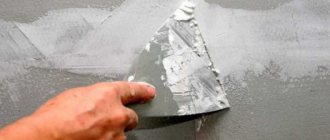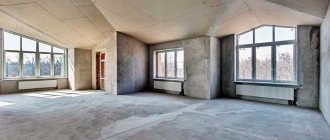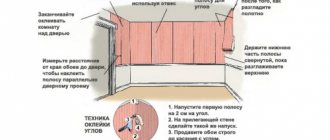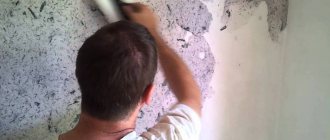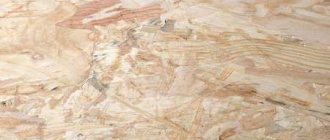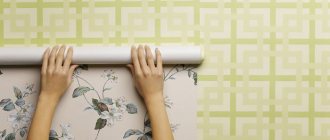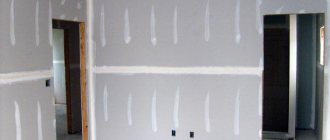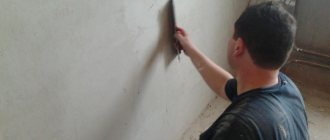In order to prevent the plaster from falling off the ceiling, the wallpaper from peeling off and the tiles to hold firmly in place, a special product has been developed - “Betonokontakt”, another name is “Concrete-contact”. The article describes the features of this type of primer, the rules for selection and application.
High-quality interior decoration is characterized not only by neatness and aesthetics, but also by durability. The panel houses in which the majority of the townspeople live are structures made of reinforced concrete slabs. Therefore, when starting to renovate their apartment, people most often deal with the smooth concrete surfaces of these slabs, be it the ceiling, walls or floors. It is quite difficult to securely attach any finishing materials to them.
Is it necessary to cover the walls with Concrete Contact before plastering?
Use concrete contact with cement plaster
or tile adhesive in most cases is not possible.
... The mixture will break the film created by the primer, the wall
will become covered with cracks, the plaster will begin to peel off, and the tiles may fall off. Typically, concrete-contact primers also have a higher price.
Interesting materials:
What is the meaning of circumcision? What is the point of an orthopedic pillow? What is the purpose of antivirus programs? What do the Japanese sleep in? What is the essence of Death Stranding? What is the essence of the matrix? How to boil white things? What should you wear to pick up your puppy? What is the advantage of using SSH over telnet? What are the features of word stress in the Russian language?
Rules of application
Using the Betonokontakt primer does not require any special skills and is accessible even to beginners in repairs, however, some nuances must be kept in mind.
Before starting work, you must thoroughly clean the surface. The strength of the connection between the materials will subsequently depend on this. Depending on the condition of the wall, you need to either clean it with a spatula, wash it, or simply wipe it free of dust. Small cracks are not a serious obstacle to work, since the adhesive properties of the composition make it possible to strengthen the top layer of the base.
When working with a cement or concrete base, it would be advisable to treat it with a regular deep penetration primer before applying the actual concrete contact in order to strengthen the outer layer and remove dust. Such preparation will improve the quality of adhesion and reduce mixture consumption.
The temperature regime at which work is carried out is of great importance. Manufacturers indicate the optimal range from 5 to 30 degrees Celsius. At the specified temperatures, the Concrete Contact primer is easy to apply and dries well. At sub-zero temperatures, the consistency changes and it becomes difficult to work; in addition, freezing significantly worsens the quality.
Before application, the primer must be thoroughly mixed in the container, since stratification often occurs during storage (due to components of different densities in its composition).
Concrete contact is applied using a foam roller or a wide brush. The thick consistency allows the primer to adhere well, so it is convenient and easy to apply. Specific colors and good density make it easy to control the uniformity of application. This is very important, since the reliability of the final finish will depend on the quality of processing.
Experts consider it most effective to apply such primer in the form of short strips, alternating vertical and horizontal. Damaged areas should be treated twice.
It is necessary to continue finishing work immediately after the concrete contact layer has dried, because otherwise it will have time to become covered with dust, and this will worsen the adhesive properties of the treated area. For the same reason, only that fragment of the floor, ceiling or wall that can be covered within the specified period should be covered with this type of soil.
If less than two days have passed after the mixture has dried, it is enough to cover the prepared area with a layer of ordinary deep penetration primer, and then continue finishing. If the break in work was longer, the concrete contact treatment will have to be repeated.
What not to do
If you are working with a primer for the first time, then first be sure to familiarize yourself with all the rules and recommendations. Next, it is very important to find out what actions with soil-concrete contact are strictly prohibited. Examples from life and the opinions of professionals prove that this list is not small. Studying it will help you avoid everyday problems and be confident in a quality result.
Thus, when working with concrete contact, the following is prohibited:
- apply to a dirty, uncleaned surface (some manufacturers allow application directly to paint or tiles);
- use over bitumen mastic;
- dilute the composition with water in greater quantities than indicated by the manufacturer in the instructions;
- apply the mixture to a wet, damp surface;
- use the composition without first stirring;
- apply to the base at negative air temperatures;
- use expired composition;
- apply the primer without waiting for complete drying;
- Continue working if dust gets on the layer. It sticks very well, but then falls off along with the plaster.
Application concretecontact | Where not to use and where it is recommended to use concrete contact
Errors at work
Due to inexperience or ignorance, building materials for intermediate installation are often used, making mistakes. The consequences of this can be unpredictable, and it is almost impossible to track the processes of destruction under finishing in a timely manner. This also applies to concrete contact.
Consequences of violating plastering technology Source kontrolstroy.ru
In reviews, there is often a remark about adhesives and leveling mixtures that they have poor adhesion to soil with quartz. This is only possible if the solution contains an excess amount of water. This drawback leads to the separation of mixtures due to a disrupted moisture transfer process and a low concentration of the binder component.
Deviations from the declared soil parameters may occur for the following reasons:
- applying the composition at temperatures below +7 – +10°C or above +25°C, at a relative air humidity above 65%;
- processing frozen or wet bases;
- finishing of an unprepared surface (dust, grease stains, affected areas, weak spots);
- inadequate drying of the coating (how long the concrete contact dries depends on the recipe, the original takes only 3-4 hours);
- wind or draft accelerates the process of water loss and the formation of dry residue, but disrupts its quality;
- adding water reduces the concentration of the binder and deteriorates the quality of the adhesive film;
- use of cheap analogues of Betokontakt for “heavy” finishing.
“Heavy” wall cladding with porcelain stoneware Source otdelkino.ru
Dust can be invisible, but it actively sticks to the primed surface. The plaster and glue will peel off from such a base. You will have to do the pre-treatment again.
The solid filler is heavier than the other components in concrete contact. It settles relatively quickly to the bottom of any working container. Therefore, it is important to stir the composition periodically.
The original soil is stored in an airtight container for only 2 years, analogues from six months. Mostly natural ingredients will most likely not cause any harm to health after the expiration date. But quality indicators will noticeably decrease. After sub-zero temperatures during storage, it will be possible to work only with frost-resistant soil. But in any case, it is applied at temperatures above +7 – +10°C to +25°C. This applies to the material, the base and the air.
Manufacturers
There are so many manufacturers on the building materials market today that it seems that choosing the right concrete contact is an impossible task. However, do not rush to panic.
Firstly: not all the mixture may be suitable. Manufacturers provide detailed information about the properties and purpose of the primer directly on the label. Just be careful here.
Secondly: the price range is quite decent. Focus on your budget and look for the best option. The abundance of products, in such a situation, only helps. If there are already favorites among the brands in terms of the quality of building materials, you can ask the seller if they produce the required concrete contact. This will also help make your search easier.
The table below provides a brief overview of the characteristics of popular brands of concrete contact. He will clarify which one is better.
| Brand and average consumption | Characteristics |
| "Knauf" 350 g/m2 | The popular brand uses quartz filler of various fractions as the main ingredient. It increases the “adhesion” of the mixture to the surface, which creates a qualitative advantage over competitors. |
| "Ceresit" 400 g/m2 | The mixture is pink. In addition to excellent functional qualities, it has proven itself to be the best in facing work. The Ceresit ct-16 soil mixture is an analogue of concrete contact, but its price tag will be higher. |
| "Axton" 300 g/m2 | A dry mixture containing marble chips instead of sand. The composition is diluted with water and mixed independently. The color of the concrete contact is white, universal - used for internal and external types of work. Its peculiarity is the possibility of application to uncleaned substrates. |
| “Prospectors” 200 g/m2 | The product composition is supplemented with latex additives. This helps it dry quickly in less than an hour, which is convenient for “quick” repairs. But it is used only for interior work. |
| "Bolars" 500 g/m2 | Concrete contact is produced with fractions of 2 types - 0.3-0.6 mm and 0.6 mm. But many note the high consumption of the mixture due to the expanded clay filler it contains. Drying time is about 12 hours. However, the material has a special advantage - resistance to frost, as well as very high temperatures (from -50 to +70 degrees). |
| "Osnovit" 300 g/m2 | "Bettokont" is suitable for work indoors and outdoors. The mixture is quite thick and requires some effort to apply, but has the great advantage of short drying time (up to 2 hours). |
| "Unis" 200 g/m2 | Concrete contact is suitable for indoor and outdoor work. The manufacturer allows the mixture to be diluted with water and treated with concrete surfaces before applying tile adhesive or plaster. |
| "Birss" 200 g/m2 | The domestic water-dispersion primer "Birss" is popular due to its low consumption and low price. The material is used for interior work and provides excellent protection against fungus. |
| "Feidal" 300 g/m2 | Premium material. Environmentally friendly composition. It is recommended to use for repair work in ancient buildings where oil paints or drying oil were used for finishing. |
| "Eskaro" 250 g/m2 | A primer that is diluted with water according to the instructions. It has an easy-to-apply texture and does not require constant stirring. However, the mixture has a strong odor, so it is recommended to work in a ventilated area and use a mask. |
Concrete contact has been selected, but it is important not to come across a fake when purchasing. In order not to waste time and effort working with counterfeits, it is better to first check the primer in use. Visually, no lumps or clots should be visible in the mixture. If there are any, return the concrete contact to the store. Next, you can do a little testing on any surface with your own hands: apply the required layer and wait until it dries completely. Did you manage to break it off? If not, great, you’ve purchased high-quality material and you can safely get to work.
Best ?
During the finishing process, it is important to understand that it is strictly not recommended to skimp on primer during application. Any professional will tell you that the thickness and uniformity of the layer play a major role in adhesion to the material. If applied incorrectly and if you save too much, there is a big risk of ruining everything: the tiles will soon fall off and the wallpaper will peel off. It is allowed to dilute the concrete contact with water only if the work will be carried out manually. Manufacturers always mention this possibility in the instructions.
How can I dilute the primer?
Even before opening the container, you should decide how to dilute the primer, according to GOST 25129-82 - solvent, xylene or their mixtures with white spirit in a percentage ratio of 1:1 are considered suitable. The proportion of solvents should not exceed 20% (in the most extreme case - 25, and then only for a quickly hardening variety).
Interesting materials:
How to present an electronic train ticket? How to present an e-ticket? How to provide an electronic ticket? How are train tickets refunded? How to enter the stadium using an electronic ticket? How to board Aeroexpress with an electronic ticket? How to check an air electronic ticket? How to check whether a bus ticket is lucky or not? How to check a train ticket? How to check a ticket on the airline website?
Recommendations
Most often, the types of concrete contact differ in the size of the grains of sand in the composition. The choice of the desired primer is made depending on the working surface. But otherwise the technical characteristics of the material are the same. The first thing you need to pay attention to when purchasing is the tightness of the container. This will guarantee the novelty and quality of the mixture. Obtaining the maximum effect is possible if you use concrete contact immediately after opening. If work with it is planned after some time, then opening the container is prohibited, and it must be stored in accordance with the manufacturer’s conditions. This way the mixture will not lose its properties and will not dry out. However, it is better to use the primer within 1 year from the date of production.
When starting to work with concrete contact, follow the recommendations:
- You cannot plaster with a cement mixture over concrete contact - only over the concrete itself. The strength of the material does not meet the standard indicators for covering with cement mortar.
- It is better to carry out work in a room with air humidity of no more than 70%.
- Pre-treatment of the base with a deep penetration primer will reduce the consumption of concrete contact and increase adhesion. However, several coats of primer may be required, depending on the substrate. This will additionally clean the surface and strengthen it (material consumption per square meter is about 300-400 g).
- Finishing can be done without special training and independently. The material does not require special knowledge or professional skills, however, if the work needs to be done quickly and efficiently, it is better to enlist support or turn to specialists.
Do you prime yourself or hire specialists?
Briefly about the main thing
Betokontakt is made from acrylic dispersion, fine-grained solid filler, and functional additives.
Almost all manufacturers add pigment additives to the composition to monitor the consistency of the coating.
The main task of the primer is to create good adhesion of solutions with smooth and dense concrete. Additionally, such substrates as ceramic cladding, brickwork, and oil paint are considered. Such surfaces are not always included in the list of acceptable ones for a particular brand of soil.
In the recommendations, you must find out information about the possible use of the material outside and in wet rooms, since not all options are universal.
Ratings 0
Video description
From the video you can get acquainted with the features of various primers:
There are points for which concrete contact is needed, but with limitations. This applies to metal, wood, plastic and glass. The expected result will be obtained only on a mineral surface with the listed inclusions. For a solid base, the option of subsequent finishing with light weight using paints and varnishes would be relevant.
Experts note deviations from the expected when concrete contact is used under self-leveling floors. If you have to work with cement mortar, the adhesion is good, but gypsum does not spread. As a result, cracks and peeling of the coating appear.
